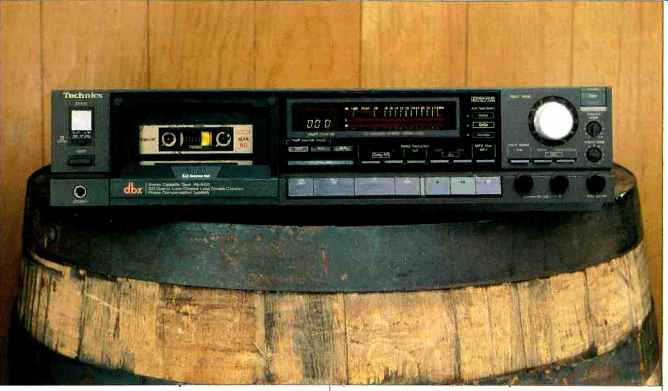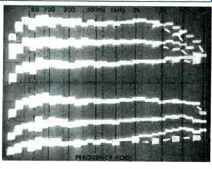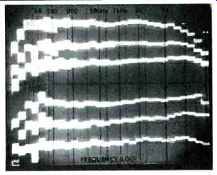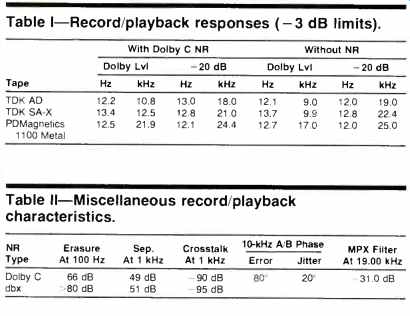
The RS-B100, Technics' top-of-the-line stereo cassette deck, has a number
of performance and convenience features. The closed-loop, double-capstan transport
has a direct-drive motor with a built-in frequency generator which is servo-compared
to the output of a quartz crystal; any deviations in speed cause an immediate
output change from the servo to maintain correct capstan drive speed. Advanced
design of the record and playback amplifiers and equalizers improves both amplitude
and phase responses and reduces distortion. The RS-B100 is a three-head deck
which, of course, allows the optimization of individual recording and playback
head designs. The overall results are better than would be possible with a
two-head unit.
== =
Manufacturer's Specifications
Frequency Response: 20 Hz to 19 kHz; to 21 kHz with CrO2 tape; to 23 kHz with metal tape.
Signal/Noise Ratio: 60 dBA; 78 dB CCIR/ARM with Dolby C NR; 92 dBA with dbx NR.
Input Sensitivity: 60 mV.
Output Level: Line, 700 mV; headphone, 125 mV into 8 ohms.
Flutter: 0.022% wtd. rms.
Fast-Wind Time: 90 S for C-60.
Dimensions: 16 7/8 in. (42.8 cm) W x 3 7/8 in. (9.8 cm) H x 10 3/4 in. (27.3 cm) D.
Weight: 11.3 lbs. (5.1 kg).
Price: $800.
Company Address: One Panasonic Way, Secaucus, N.J. 07094.
== =
The Technics deck includes both Dolby B and C NR as well as dbx NR, giving the recordist great flexibility in working for the best results under different conditions. The wide range fluorescent meters have a three-color readout for speedy and accurate display of record and playback levels.
There are front-panel adjustments for record-level sensitivity and bias, and switchable 400-Hz and 12.5-kHz oscillators for the necessary trimming, using the level meters in an expanded-scale mode for accuracy. This combination permits matching of the deck to the characteristics of most tapes, which can vary quite a bit. Other convenience features include automatic tape-type selection, "Auto Rec Mute," and a three-way digital counter.
Control Layout
The light color of the front-panel designations make them quite legible in normal lighting, contrasting well with the dark brown and black of the panel. The timer slide switch ("Rec/ Off/Play") is immediately below the power switch pushbutton at the far left (the best place for it, in my view). Immediately below are the "Eject" button, which gets a smooth and gentle tilt out of the carrier, and the headphone jack.
The light behind the tape compartment is brighter than usual, facilitating fast checks of the tape pack's status. Each time the compartment closes, the supply hub spins backward for about 1 S, taking up any tape slack in the cassette.
You need a fairly firm push upwards to remove the tape carrier door cover, but it's well worth doing when cleaning or demagnetizing because there's excellent access once it's off.
To the right of the tape compartment is the counter, with its controls just below. The "Tape" and "Time" buttons switch the display between the three-digit tape-position mode and the time-remaining mode, but the latter has some limitations. In the time mode, the counter does not actually sense tape position; it merely counts down from a time you select by pressing the "Time" button an appropriate number of times-once for 15:00, twice for 23:00 and so on, through 30:00, 45:00 and 60:00. Because these times correspond to the nominal lengths for one side of standard blank cassettes, this feature is handy if you're starting at the beginning of the tape but not if you start in the middle. Also, this is not a true time-remaining counter: It's a stopwatch function, counting time spent in playback or recording but switching back to "Tape" mode during fast-wind. You cannot, for instance, use this function to find something you remember being 5 minutes back along the tape. A third mode of the counter/timer displays the duration of record mute. If "Auto Rec Mute" is pushed and released while in record mode, the muting will continue for 4 S, counted out in the display, and the deck will go into record/pause mode. If the mute button is held in, muted recording will continue until it is released, with the time duration on display.
To the left of "Auto Rec Mute," along the bottom center of the panel, are the rest of the large, transport-control pushbuttons, which require only a light touch. Changes in mode are direct, in general, but recording can be entered only from "Stop" or "Pause." I do feel that high-end decks should offer punch-in (flying-start) recording during play-anyone who holds in "Play" and pushes "Rec" is not doing so by accident. Fast winding (forward or reverse) to the beginning of a selection and initiation of playback at that point is possible by pushing "MS" (music select), a control just above the "Counter Reset" button, before starting the winding. An "MS" annunciator above the counter display indicates that this mode is operative. "Play" and "Pause" have light-green indicators, and "Rec" has a red one.
Above the transport buttons are five interlocked pushbuttons to select Dolby B or C NR, no NR, dbx encoding/ decoding for tape, dbx decoding-only for disc, and the MPX filter for Dolby. The buttons used in tape recording and playback with NR (the two Dolby settings, "dbx Tape" and "MPX Filter") have light-green indicators; the "dbx Disc" setting, which is not used for taping, has a red light.
The "Disc" setting, found on several dbx-equipped tape decks, allows dbx-encoded discs to be played without a separate decoder. In this mode, the monitor switch is automatically set to "Source," so it can be used with no tape running and so that you will not accidentally "decode" a non-dbx tape if you go into play mode. The red indicator warns that this switch position will not encode or decode tapes, and that its accidental use to expand signals not previously compressed by dbx encoding could possibly yield enough volume to damage equipment.
The horizontal, fluorescent bar-graph meters have 18 display segments for each channel, reading from-40 to + 18 dB, with meter zero at 2 dB below Dolby level. The segments up to and including zero are light blue, those from + 1 to + 8 dB are orange, and the segments at + 12 and + 18 dB (which illuminate only when dbx NR is in use) are red. The above-zero hues not only are colorful but, more important, indicate where caution in controlling recording levels is in order. Momentary (2-S) holds on peaks supply additional clues for the recordist.
Just to the right of the meters are the annunciators for "Auto Tape Select," which indicate " Normal," "CrO2" or "Metal" tape formulations. Further to the right is the large "Input Level" knob. The RS-100B comes with a silver-colored knob installed, but a second, dark-colored knob is provided to match the dark panel. At the upper right corner is the "Monitor" button, with illuminated "Tape" or "Source" indication. This automatically switches to "Source" mode when the deck is in record-pause mode, so you won't miss any sound cues (announcements, needle scratch, etc.) telling you when to start recording. Unlike most such automatic monitor selectors, however, it does not switch back to "Tape" when you start recording. I found it a nuisance to have to switch back manually each time.
Below the monitor switch are the small "Balance" and "Output Level" knobs. To the left of the latter are three interlocked switches which select either the normal stereo "Line" input (there are no mike inputs) or the recorder's built-in test tones, used with the unusually prominent calibration-control knobs just below.
The manual calibration procedures are quite simple. For record-level calibration, you first set the monitor to "Source," press the "400-Hz" oscillator-tone button, and adjust the input controls so the signal reads "0" on the meters. Then you start recording, switch the monitor to "Tape," and adjust the " Rec Cal" pots until each meter reads zero again. Bias setting procedure is similar, except that you press the "400Hz/12.5-kHz" oscillator button, and adjust the bias for simultaneous zero readings on both the upper meter bar (which reads the 400-Hz tone) and the lower bar (which reads the 12.5-kHz tone). The test signals are all actually recorded at -20 dB, but the meter range is shifted and expanded, for both tests, so the signals will read at zero and so that each meter step near zero will correspond to 1 dB. The center-detented calibration knobs carry numerical scales, so you can quickly return to known adjustments without repeating the calibration tests.
On the back panel are the usual in/out stereo phone jacks as well as a DIN jack for the optional remote control. A look at the internal construction showed a large, almost chassis sized p.c. board which also serves as a motherboard; it holds some vertical cards, such as the two noise-reduction cards and the power supply. The soldering was excellent, with little flux residue, even at the hand-soldered points. All parts were identified by number. Multi-conductor cabling was used for inter-card connections.
The transport was very quiet, particularly in play mode, and its construction appeared to be quite rigid. Although there was a large flywheel, it was difficult to see internal details. The general chassis construction was acceptably rigid, but there was no internal side rail on the right side, making the front panel springy with the cover removed. In my judgment, the unit would be good for rack-mounting (adaptors are supplied) only in stationary installations. The power transformer had good shielding and was not overly warm after a long period of use. I saw no fuses, inside or out, but there may have been other protective devices.
Measurements
The playback responses were very good at both equalizations, with about a 2-dB rise in level at the highest frequencies. The RS-B100 came supplied with samples of TDK AD, SA-X and MA-R tapes, but over 30 formulations were tried, using the deck's calibration scheme to good effect with the great majority of them. Most Type I tapes could be matched very well, but low-bias tapes were marginal, and the hottest tapes (such as TDK AD-X) showed high-end peakiness. The Type II formulations were all matched quite well, although there was a slight high-frequency droop with a couple of minor brands. Most metal tapes showed quite a high-end boost, including TDK MA-R. I decided to use PDMagnetics 1100 Metal for the Type IV tape because it had a smoother response, but I did stick with the TDK-AD (Type I) and SA-X (Type II) because they were judged to be the match of any others tried.
Figure 1 shows the record/playback responses, with and without Dolby C NR, using pink noise and a Ys-octave RTA. Table I lists the-3 dB points, measured using a sine-wave source. The 0-dB responses are quite good but not outstanding. At both this level and 20 dB below, high-frequency response becomes more extended as you go from Type I tape to Type II and then Type IV tape. The Dolby C NR tracking is excellent with TDK AD and SA-X; although the Type IV results suffered in comparison, the mistracking there was not great. I should also note that other Type IV formulations did not do as well as the PDMagnetics tape. In general, the 20 dB responses have excellent flatness from 30 Hz to 16 kHz.

Fig. 1--Record/playback responses with (solid traces) and without (dashed traces)
Dolby C NR. Upper three traces: TDK AD (Type I), TDK SA-X (Type II) and PDMagnetics
1100 Metal (Type IV) tapes, all at Dolby level. Lower three traces: AD, SA-X
and 1100 Metal, all at-20 dB. (Vertical scale: 5 dB-div.)

Fig. 2--Record/playback responses with dbx NR. Upper three traces: TDK AD (Type
I), TDK SA-X (Type II) and PDMagnetics 1100 Metal (Type IV) tapes, all at
Dolby level. Lower three traces: AD, SA-X and 1100 Metal, all at -20 dB.
(Vertical scale: 5 dB/div.)
For all tests with this deck, I recalibrated its recording level and bias for each tape before switching in NR or taking any data. Figure 2 presents the Dolby-level and-20 dB record/playback responses with the three tapes, using dbx NR. The-20 dB responses are quite good (SA-X) to excellent (1100 Metal), but the responses at 0 dB were a puzzle when first run. Having seen a number of decks with flat responses with dbx NR up to +5 dB, I first thought I had made a mistake in level setting. A short test sequence revealed that whereas the other decks had the dbx unity gain point as much as 8 to 10 dB below Dolby level, the Technics deck was set for dbx unity gain at close to meter zero, or -2 dB re: Dolby level.

Table I--Record/playback responses (-3 dB limits). Table II--Miscellaneous record/playback
characteristics.

Table III--400-Hz HDL3 (%) vs. output level (0 dB = 200 nWb/m). Table IV--Signal/noise
ratios with IEC A and CCIR/ARM weightings.

Table V--HDL3 (%) vs. frequency at 10 dB below Dolby level. Table VI--Input
and output characteristics at 1 kHz.
Let me clarify what I am referring to here. With the dbx system, there is compression during encoding (before recording), with the highest levels reduced somewhat and the lowest levels increased considerably. In decoding the playback, the highest levels are expanded somewhat and the lowest levels are reduced greatly (downward expansion), returning the signals to their original character with an attendant reduction in noise. The level towards which other levels are compressed in recording-and away from which they are expanded in playback-is the unity-gain point or unity gain level. For the dbx system to reduce distortion at the highest levels, and particularly to maintain extended high frequency response, the unity-gain level in recording must be lower than the point where distortion is already high or the point where tape saturation effects are already detrimental. The 0-dB responses of the RS-B100 do match those for Dolby C NR, but as indicated above, I would prefer a lower unity-gain level for improved high-end performance at high levels.
Table II lists the results of various brief tests of record/ playback characteristics. In general, the results are excellent, although the 80° phase error at 10 kHz is somewhat high. Note that dbx NR improves the deck's erasure, separation, and crosstalk. Tape play levels were indicated accurately on the right channel, but one segment low on the left.
Tape play speed was as accurate as could be determined by the test tapes available, less than 0.1% off. The record calibration pots had a range from-10 to +7 dB relative to the center detent using TDK SA-X. The 400-Hz (394-Hz actual) oscillator had about 1.5% distortion, and the 12.5 kHz (12.7-kHz actual) oscillator appeared to be substantially distortionless, though perhaps because the deck's roll-off was filtering out its distortion products.
The level of third-harmonic distortion was measured from -10 dB to the points where it equaled 3% for all three tapes and with both Dolby C and dbx NR. One thing that's most obvious in Table III is that much higher maximum levels are possible with dbx NR using the 3% distortion limit.
At low recording levels, as is the normal case, there was generally less measured distortion with Dolby C NR than with dbx NR. Table IV lists the signal-to-noise ratios with the three tapes for two NR systems, both with IEC A and with CCIR/ARM weightings. The figures are very good: Those for dbx NR are over 94 dBA, and TDK AD had 76.6 dB CCIR/ARM. The results were a little disappointing for the Type II tape, more so for the Type IV. Table V shows how distortion varies with frequency at 10 dB below Dolby level using PDMagnetics 1100 Metal tape and with Dolby C and dbx NR. At this level there is less distortion with Dolby C NR, especially at the lowest frequencies. The distortion rise at the frequency extremes is moderate, less than with many other decks. However, the mid band distortion would be lower with TDK AD tape.
Miscellaneous input and output characteristics are listed in Table VI. The attenuation of the two sections of the input level pot tracked within 1 dB for just over 60 dB, one of the best. The output-level pot sections tracked within 1 dB for 40 dB. The headphone listening levels were very high with all phones tried, but critical listening at lower levels might require choosing a set of higher sensitivity. The polarity of the output was reversed in both "Source" and "Tape." The bar-graph meters had very fast response, reaching full indication in 30 mS, but they were not fast enough to be classified as true peak-responding meters. They also showed no increase in deflection with positive and negative d.c. offsets added to the tone burst, whereas true peak meters will react to such offsets. The meters' responses were 3 dB down at 30 Hz and 26.2 kHz. The level calibration relative to meter zero was very good from -12 to +6, but +8 and above needed lower actual values to turn on, while -40 turned on at-33.3 dB actual. The momentary peak hold time varied but was more often 1S than the 2S claimed. The meter's 20-dB decay time was 320 mS, on the short side for fast-responding meters.
There was no measurable change in tape play speed when line voltage was varied anywhere from 110 to 130 V. Play speed variations were within ±0.01% over a short period of time. Flutter was very low throughout a C-90 cassette: 0.036% weighted rms and ±0.06% weighted peak. At times, the record/playback flutter reached the very low specified figure of 0.022%, but the figures given just above were more typical of the results with a number of cassettes. Fast-wind times for a C-60 were just over 80 S. Changes in transport mode took 1S, except that it took 2 S for the deck to switch into "Stop" mode after the tape ran out in fast-wind.
Use and Listening Tests
The owner's manual has several large connection and operation diagrams-which is good-but some of the details confused more than they clarified the subject. The text was generally very good, with many helpful notes. The paragraph on dbx NR is in error where it states that, in playback, "Strong signals are greatly expanded and weak signals are expanded in a small way .... " An accompanying figure in the manual illustrates the action correctly.
All controls and switches were completely reliable throughout the testing. The calibration scheme worked very well for the tapes tried, with the exception that bias trimming was unavailable for metal tapes, which I felt could have used some. I liked the wide choice of NR systems and the automatic switch to "Source" monitoring in the "dbx Disc" mode. I did not, however, appreciate the monitor's switching itself during "Rec/Pause" without switching itself back when I resumed recording.
I did use the music-selection system ("MS") to good advantage, as I did the tape/time counter in winding back to the start of recording when I had to start Over. I was frustrated, however, that this feature was nonoperational after 30 S of recording, and that the deck has no other memory to enable a fast-wind to "000" when desired.
There were no record or pause sounds detected by ear or meter, and a stop caused a soft clunk, just barely out of tape noise, even with Dolby C NR. Although the meter dynamics were not quite what I prefer, the display conveyed level information very well, helping in speedy level-setting. The peak holds were usually about 1 S; a longer time would have helped.
It was possible to hear an increase in the high-frequency energy with Dolby C NR switched in when using metal tape, but with most music the change was pleasant. There were no response shifts noted with the other tapes or with dbx NR. Respighi's Feste Romane with Lorin Maazel and the Cleveland Orchestra (Mobile Fidelity MFSL 1-507) copied very well up to fairly high levels with all three tapes, each with two types of noise reduction (Dolby C and dbx). Some low-frequency muddiness prevented recording all the way to full-scale with dbx NR, something that was possible with less-demanding music.
The Technics RS-B100 cassette deck has excellent responses that exhibit some roll-off at the higher levels. The distortion and noise performance was very good, but the results with metal tape were disappointing. The stability of the tape transport was excellent, and the low flutter probably aided in the clarity of the sound. The RS-B100 is a relatively compact unit .with rack-mounting, and that is worth keeping in mind when looking for a deck in its price range.
-Howard A. Roberson
(Audio magazine, March. 1985)
Also see:
Technics RS-M275X Cassette Deck (Mar. 1983)
= = = =